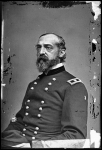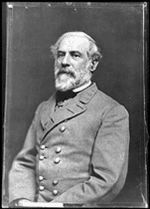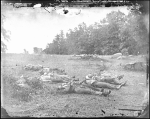 The
Battle of Gettysburg The
Battle of Gettysburg
|
|
|
General George G. Meade, for the Union, was hired by Abraham Lincoln to
stop General Robert E. Lee, of the Confederates, from advancing into the
north. Meade and Lee were both trekking north knowing that the enemy
was probably only two to three days away. Meade was looking for a
good defensive line near the Maryland border where he hoped to face Lee.
Meade and Lee were both headed toward the little town of Gettysburg to
spy on each others movements. |
|
As they approached Lee started drawing his men together while Meade was
still widely spread out. |
|
Unknown to Lee Yankee cavalry held the town while Heth and Davis, of the
Confederates, were studying a way to get around the town. Heth ordered
Davis to the south and Archer to the north while the Union’s two brigades
of cavalry prowled around the town. While Archer on his mission bumped
into them with is infantry brigade. The Union managed to hold them
off for about an hour. After Archer got through he marched right
into fresh Union infantry where he was captured. Davis hitting strong
ended up having most of his brigade taken prisoner. |
|
During this Meade was about nine miles south of town, but had received
notice from Hancock Gettysburg would be the best place to make a stand
against Lee. He arrived at 11:30 p.m. on July 1 at Cemetery Ridge
(the first of three days battle). Cemetery Ridge was best the best
place for a defensive line which is where Meade made the Union’s headquarters..
After the first day of battle 18,000 men fought for the Union over half
were killed. |
|
Lee made headquarters at Seminary Ridge, he wanted Culp’s Hill. He
moved Ewell to the right, but unknown to Lee General Slocum, of the Union,
already had troops there. |
|
On the second day Lee had to fight with his guys in a crescent. Lee
told Longstreet to attack Union left with 16,000 men. During this
Sickle, of the Union, was about to be attacked and he wouldn’t be able
withstand it unless on higher ground. So he decided to move to a
supposed stronger point without Meade’s permission. Longstreet had
already attacked Sickle before Meade could get him back and Sickle suffered
devastatingly. After the second day the Confederates had many men
and gained little ground. |
|
When July 3 came about the battle picked up where it left off. Ewell
still clung to the slopes of Culp’s Hill while Longstreet had to take 12,000
men and march over 1,000 yards in the open. This forced Meade to
relocate headquarters to Power’s Hill. Pettigrew now with Pickett,
of the Confederates, moved eastward, and began to bunch near the center.
The Union formed an almost 90 degree angle, and the Confederates were forced
to seek cover. Hand-to-Hand combat broke out which was later called
“Pickett’s Charge.” The Confederates were drove out and now badly
outnumbered and cutoff from reinforcements. They retreated back to
Seminary Ridge. Pickett had lost nearly 3,000 men. Meade wanted
to stay put and not risk an attack on Seminary Ridge. |
|
The next day on July 4th Lee saw no point in continuing fight and retreated
back to the south. |
|
They say it was the turning point in the war because the south would know
have to fight on southern soil. |
|
The casualties were great for both sides. The Union had 3,155 killed,
14,530 wounded, and 5,365 missing which totaled 23,040 men. The south
had 2,600-4,500 killed, 12,800 wounded, and 5,250 missing which totaled
20,650-25,000 men. It was pretty devastating for both even though
the Union won. |

|
|
Click
here to view Photo Gallery
|
|
BIBLIOGRAPHY
Caton, Bruce,
"The Battle of Gettysburg", American Heritage Publishing Company, 1936 |
Hakim, Joy, "A
History of US", Oxford University Press, Volume 3, 1994 |
|
Williams,Brian,"Welcome
to Military History Online-Battle of Gettysburg",Military History Online,
<http://www.militaryhistoryonline.com/gettysburg>,(November
1,2000) |
|
|
| Christopher
Fox |


 The
Battle of Gettysburg
The
Battle of Gettysburg
